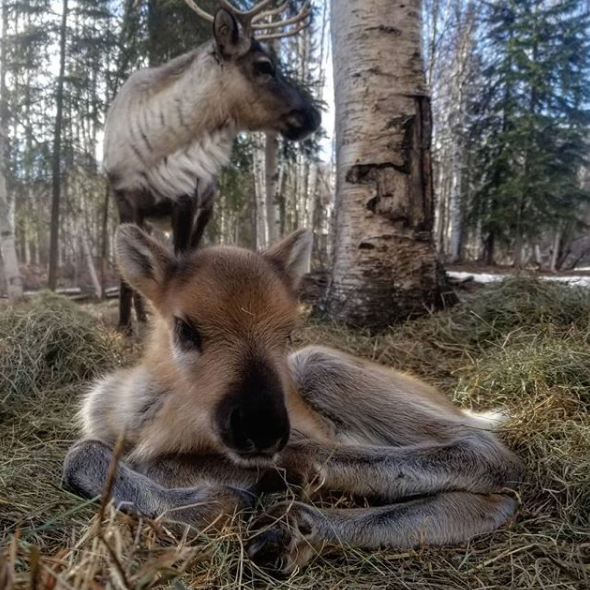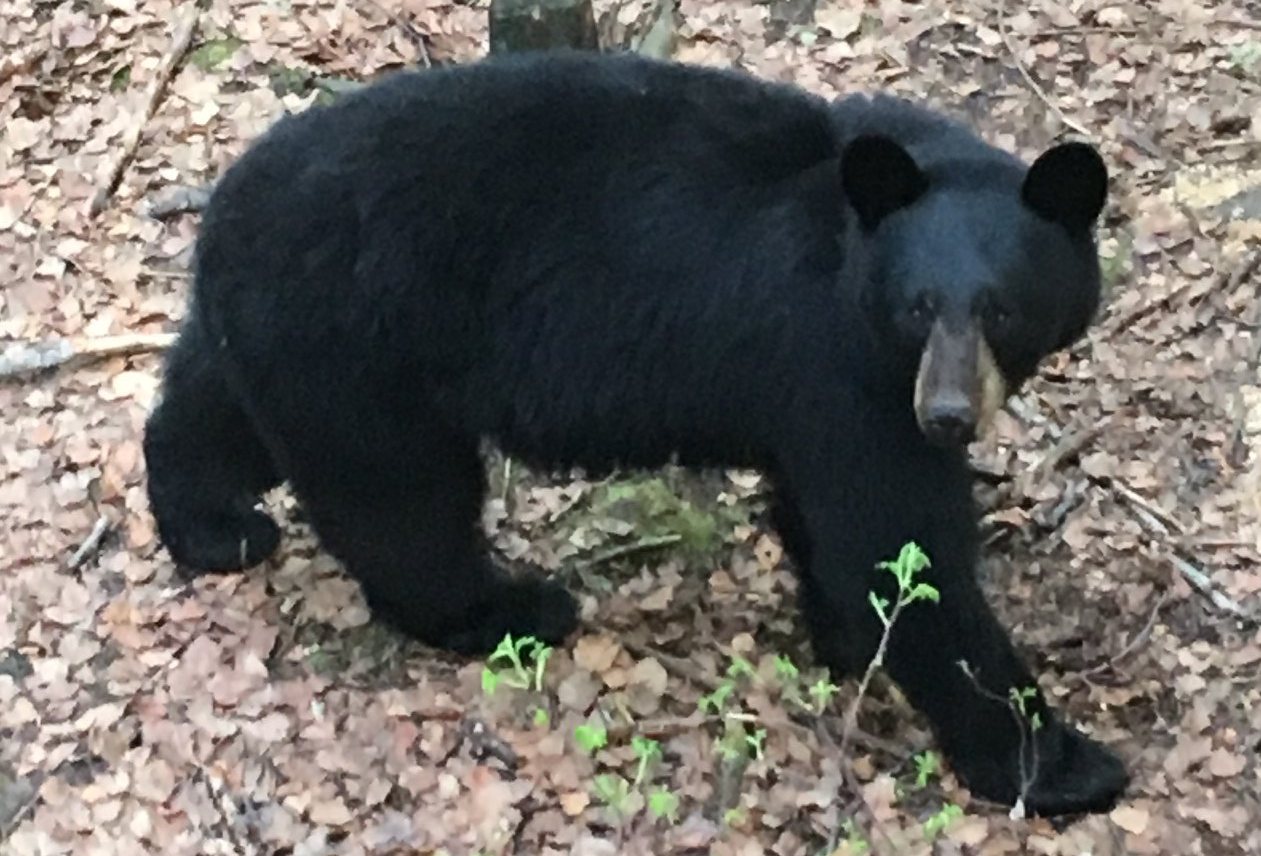
Photo by Frank Stelges/Aurora Bear Photography School
A prime attraction for visitors to Alaska is the opportunity to view some of the most beautiful animals in the world, and when you ask a local what they love most about living here, they will often site Alaska’s extraordinary wealth of wildlife. As you explore the Last Frontier, we’ve assembled this at-a-glance guide to five land mammals you’re likely to find in the Fairbanks vicinity or in areas nearby.
Moose
 Moose are a common part of life for most Alaskans. These massive, hulking creatures wander through our sports fields, poke around our neighborhoods and nonchalantly cross our roads and highways, forcing motorists to be on the lookout and cautiously wait for them to pass.
Moose are a common part of life for most Alaskans. These massive, hulking creatures wander through our sports fields, poke around our neighborhoods and nonchalantly cross our roads and highways, forcing motorists to be on the lookout and cautiously wait for them to pass.
While moose are generally happy to pose for a picture or two it is important to give them lots of room, especially when calves are nearby. Generally, they ignore people and human activities and are more interested in food.
In summer, moose prefer swampy areas, such as ponds, sloughs, muskeg, creeks and rivers, where they feed on shrubs and aquatic plants and they’re most active in the evening. They are known to forage all over town, or in the wetlands of Creamer's Field Migratory Waterfowl Refuge. Another great place to spot moose is on Chena Hot Springs road, especially within the Chena River State Recreation Area.
In winter, finding food is difficult, and moose flood the low areas, often taking refuge in cities. There, the moose live off the locals' gardening and landscaping efforts. This also means that moose will be more likely to wander into the roads and highways. Photo by © State of Alaska/Michael DeYoung.
Caribou/Reindeer
 Caribou are distributed in 32 herds in the Arctic tundra, mountain tundra and northern forests of Alaska and number close to one million strong. They travel in large herds during spring and fall migrations but are often seen in small bands or as individuals during the summer. On warm, still days, caribou are found above the timberline in windy areas or on isolated snow patches where they seek relief from insects. You may find them crossing major highways during the spring and fall migrations.
Caribou are distributed in 32 herds in the Arctic tundra, mountain tundra and northern forests of Alaska and number close to one million strong. They travel in large herds during spring and fall migrations but are often seen in small bands or as individuals during the summer. On warm, still days, caribou are found above the timberline in windy areas or on isolated snow patches where they seek relief from insects. You may find them crossing major highways during the spring and fall migrations.
Caribou are the only member of the deer family in which both sexes grow antlers. Antlers of adult bulls are large and massive; those of adult cows are much shorter and are usually more slender and irregular. Caribou are clove-brown with a white neck, rump and feet and often have a white flank stripe. Caribou in northern and southwestern Alaska are generally smaller than caribou in the Interior and in southern parts of the state.
In Alaska and Canada domesticated caribou are called reindeer. Here in Fairbanks, there are visitor attractions that include experiences with reindeer and are a popular way to learn about these fascinating animals and snap an up-close Instagram-worthy photo. Photo by Archipelago Farms.
Black Bear
 Black bears are the most abundant and widely distributed of the three bear species in northern Alaska. An estimated 100,000 black bears inhabit Alaska. Look for them in summer fishing along streams with spawning salmon. In late summer and fall, they are often found feeding on berries in open meadows or on the tundra. Still, while black bear populations are plentiful in Alaska's interior, sightings are rare outside of national parks and state recreation areas. Bring along potent bear spray if you're hiking outside of urban areas, just in case.
Black bears are the most abundant and widely distributed of the three bear species in northern Alaska. An estimated 100,000 black bears inhabit Alaska. Look for them in summer fishing along streams with spawning salmon. In late summer and fall, they are often found feeding on berries in open meadows or on the tundra. Still, while black bear populations are plentiful in Alaska's interior, sightings are rare outside of national parks and state recreation areas. Bring along potent bear spray if you're hiking outside of urban areas, just in case.
Black bears can vary in color from jet black to white. Black is the color most frequently encountered across the Interior. They often have brown muzzles and some also have a patch of white hair on their chest.
Black bears are most easily distinguished from brown bears by their straight facial profile and their claws, which rarely grow more than 1.5 inches in length. Black bears have an adequate sense of sight and hearing but have an outstanding sense of smell. Photo by Leo Faro.
Fox
 The red fox can sometimes be seen darting across the road in woody, brushy areas. If you are lucky you may see one with the “cross” coloration—a dark band crossing the shoulders and back. The Arctic fox is white in winter and gray or brown in summer. Its ears and body are smaller compared to the red fox. Look for it north of the Brooks Range.
The red fox can sometimes be seen darting across the road in woody, brushy areas. If you are lucky you may see one with the “cross” coloration—a dark band crossing the shoulders and back. The Arctic fox is white in winter and gray or brown in summer. Its ears and body are smaller compared to the red fox. Look for it north of the Brooks Range.
Although foxes trot at a steady pace and sprint up to 30 miles per hour (48 kph), they don’t chase prey like coyotes and wolves do. Instead, they pounce on it. A fox will stalk a mouse, then spring into the air and come back down, using its forepaws to pin the prey. Photo by Explore Fairbanks.
Lynx
 The lynx is the only cat native to Alaska. These gorgeous creatures are found across most of mainland Alaska. Look for this very shy animal in the spruce and birch forests, particularly in spots where young vegetation attracts their preferred food, hare. Mice aren’t big enough to sustain them and Arctic ground squirrels and marmots hibernate all winter, so lynx have evolved as specialist predators, and their specialty is snowshoe hares. Seeing a lynx in the wild is something special as this animal is very elusive. Like domestic house cats, they hunt and prowl at night, which makes them even harder to spot. At first glance, lynx look a little out of proportion. The feet are too big for the legs and the legs are too long for the body. However, it has the perfect physique for traveling in deep snow. Photo by National Park Service.
The lynx is the only cat native to Alaska. These gorgeous creatures are found across most of mainland Alaska. Look for this very shy animal in the spruce and birch forests, particularly in spots where young vegetation attracts their preferred food, hare. Mice aren’t big enough to sustain them and Arctic ground squirrels and marmots hibernate all winter, so lynx have evolved as specialist predators, and their specialty is snowshoe hares. Seeing a lynx in the wild is something special as this animal is very elusive. Like domestic house cats, they hunt and prowl at night, which makes them even harder to spot. At first glance, lynx look a little out of proportion. The feet are too big for the legs and the legs are too long for the body. However, it has the perfect physique for traveling in deep snow. Photo by National Park Service.
Special thanks to the Fairbanks Alaska Public Lands Information Center for help with this content.
Wildlife Viewing Dos and Don'ts
Here are a few dos and don’ts to get the most out of your wildlife viewing, while staying safe and being mindful of viewing animals without changing their behavior.
- Do not get close to wild animals. Be respectful of the animal’s space. Wild animals are very unpredictable and can hurt you.
- Do bring binoculars and a telephoto lens. These will bring far away objects into view and reveal colorful details even when you’re relatively close.
- Do bring along a reference book or field guide. These can describe the best times and places to find animals and how to identify tracks and other signs.
- Do stop by the Morris Thompson Cultural and Visitors Center to speak with a National Park Service ranger at the Alaska Public Lands Information Center. They will show you maps and brochures and share their vast knowledge about the natural habitat of the area.
- Don’t bring your pets. Most animals avoid them and having a pet around will greatly reduce your chances of seeing wildlife.
- Don’t stop on the highway without ample room to pull off. This is dangerous and impolite to other motorists. Find a safe spot to pull over and quietly exit your car, so you don’t frighten the animal away.
- Don’t try to rescue “orphaned” animals. Young calves and cubs that appear to be alone usually have protective parents nearby.








